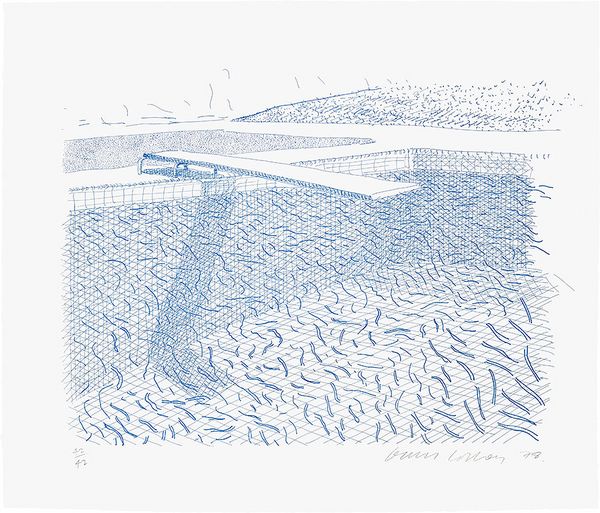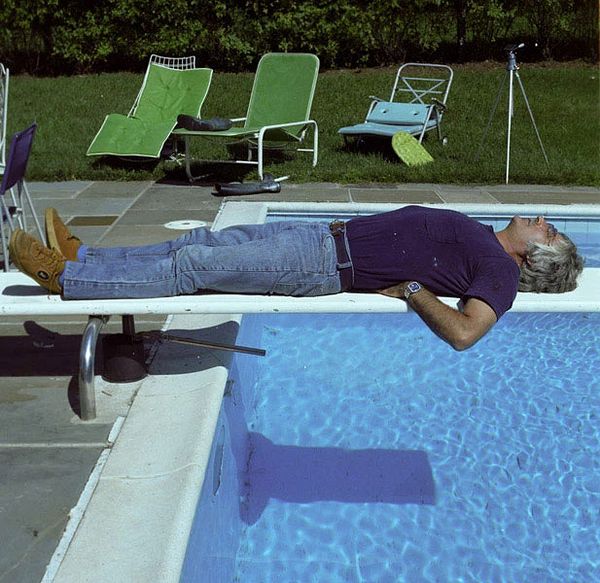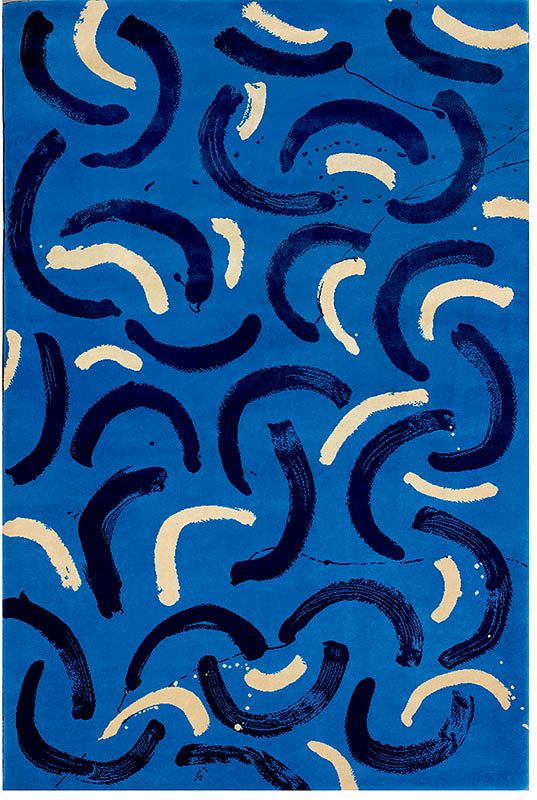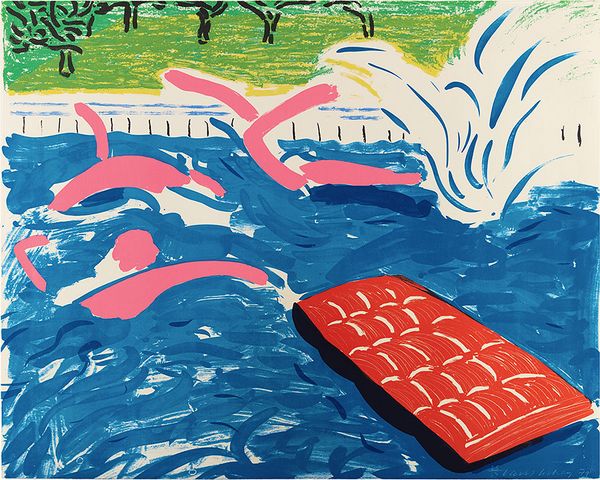David Hockney, Afternoon Swimming, 1979. David Hockney.
Instantly recognisable, David Hockney’s swimming pools are widely identified as the artist’s most famous motif. Embodying his fascination with the hedonism of post-war America, swimming pools have also served as a metaphorical springboard into an extended investigation spanning decades of Hockney’s career: the formal challenge of representing water.

David Hockney, Lithographic Water Made of Lines, 1978. David Hockney.
It is an interesting formal problem; it is a formal problem to represent water, to describe water, because it can be anything. It can be any colour and it has no set visual description.
– David Hockney
Swimming pools became a staple of Hockney’s oeuvre early in his career. Flying into Los Angeles for the first time in 1963, Hockney looked out of the airplane window and was immediately captivated by the striking blues of the countless swimming pools scattered across the city below. Following a move to this “promised land” in 1964, Hockney visually defined Los Angeles through his celebrated pool paintings, including A Bigger Splash (1967) which currently resides in Tate Britain’s permanent collection.
Hockney’s pool paintings of the 1960s exemplify his initial approaches to rendering water, executed almost exclusively in acrylic paint. Yet, in 1978, he embarked on an intense period of experimentation, encouraged by his close friend and master printmaker, Kenneth Tyler. While staying with Tyler in New York, Hockney began a series of several editions of swimming pool lithographs while also working on his Paper Pools – unique works made of dyed paper pulp which resulted in a cross between painting, printmaking, and paper making. Engaging with a concern that has occupied artists throughout history, Hockney’s lithographs from this period focus on the formal challenge of representing water.

Kenneth Tyler resting on the diving board of his swimming pool. Photo: © Lindsay Green.
Ken [Tyler] had a swimming pool in the garden… I kept looking at the swimming pool… it is a wonderful subject – water, the light on the water… every time you see it, it takes on a different character. You look at the surface, you look below it, you look through it, every day it looks different
– David Hockney
Lithographic Water Made of Lines is one of eleven editions of lithographic prints that Hockney produced of the same scene between 1978 and 1980. Printing from a single aluminium plate, Hockney here concentrates on the individual graphic lines and shapes that portray both the depth and movement of the pool. While other editions in this series use various washes to capture the everchanging light conditions, this example focuses solely on depicting the water’s characteristics. The graphic marks utilized in Lithographic Water Made of Lines continued to inform Hockney’s approach to depicting water and are again visible in Pool Made with Paper Blue Ink for Book, from Paper Pools. As with his earlier swimming pool lithographs, the stillness of the protruding diving board here contrasts with the dynamic blue gestures that make up the heavily marked surface of the pool below. Created to accompany a publication on the Paper Pools series, Pool Made with Paper Blue Ink for Book, from Paper Pools emphasizes the interconnected nature of Hockney’s swimming pool images, despite the varied media he was using.

David Hockney, Paper Blue Ink for Book, from Paper Pools, 1980. David Hockney.
The fluid marks that Hockney frequently used to evoke the movement of water also pay homage to Henri Matisse’s earlier iteration of the same subject: The Swimming Pool (1952). The influence of Matisse is also clearly visible in the figures included in Hockney’s large-scale lithograph, Afternoon Swimming. The flat and simplistic qualities of Matisse’s paper cut-out swimmers are replicated in Hockney’s three figures, whose limbs mirror the undulations of the water and further add to the dynamism of the work. Incorporating an iconic Hockney splash as well as a vibrant inflatable in the foreground, Afternoon Swimming evokes the hedonism and jubilance of the artist’s earlier sun-drenched pool paintings.
I believe that the problem of how to depict something is… an interesting one and it’s a permanent one; there is no solution to it. There are a thousand and one ways you can go about it. There is no set rule.
– David Hockney
Attesting to the fruitful and longstanding creative relationship between David Hockney and Ken Tyler, Lithographic Water Made of Lines, Afternoon Swimming and Pool Made with Paper Blue Ink for Book, from Paper Pools were all printed by Tyler Graphics Ltd. However, Hockney’s fascination with depicting water extended well beyond the studio. By 1978, Hockney had painted bold blue arcs on the bottom of his own backyard pool, and the same comma-like shapes still decorate the historic Hollywood Roosevelt hotel’s swimming pool, which Hockney painted one sunny LA morning in 1988. When someone dived in and disturbed the water, “all the commas seemed to come to life, weaving and dancing and shimmering,” according to an article in the Los Angeles Times. Hockney’s iconic treatment of water was further immortalized in yet another medium in 1988, when he collaborated with the German homeware conglomerate Vorwerk to produce Swimming Pool Carpet from the Arterior Collection in machine-woven wool.

David Hockney, Swimming Pool carpet from the Arterior Collection, 1988. David Hockney.
Recommended Reading
